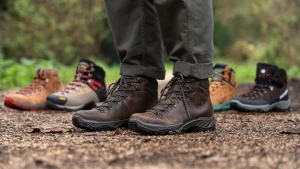How to Choose the Right Hiking Boots Without Breaking the Bank

Embarking on outdoor adventures requires proper footwear, especially when it comes to hiking. Choosing the right pair of hiking boots is crucial for comfort, support, and safety on the trails. However, it doesn’t have to break the bank. Here’s a guide on selecting budget-friendly hiking boots without compromising quality.
1. Determine Your Hiking Style
Before diving into the vast selection of hiking boots, assess your hiking style and preferences. Consider the terrain you’ll be tackling, the duration of your hikes, and the weight you’ll be carrying. For day hikes on well-maintained trails, lightweight hiking boots with flexible soles may suffice. For rugged terrain and longer treks, opt for more durable boots with stiffer soles and ankle support.
2. Focus on Fit and Comfort
A proper fit is paramount when it comes to hiking boots. Visit a reputable outdoor retailer to get fitted by trained staff who can assess your foot size and shape. Ensure there’s ample room in the toe box to prevent discomfort and blisters on downhill sections. Walk around the store wearing the boots to gauge comfort and support, paying attention to any pressure points or areas of rubbing.
3. Consider Waterproofing
Weather conditions can be unpredictable in the great outdoors, making waterproof hiking boots a valuable investment. Look for boots with waterproof membranes such as Gore-Tex or eVent, which offer protection from rain, puddles, and stream crossings while allowing moisture to escape from the inside. Waterproofing enhances comfort and keeps your feet dry, particularly during wet weather or when hiking through dewy grass.
4. Assess Traction and Stability
Traction is essential for navigating various terrains, from rocky trails to muddy paths. Look for hiking boots with aggressive lugs and durable outsoles that provide reliable grip on different surfaces. Boots with Vibram or Continental rubber outsoles are known for their superior traction and durability. Additionally, consider boots with features like a shank or midsole plate for added stability and protection on uneven terrain.
5. Evaluate Durability and Support
Durability is key when it comes to hiking boots, especially if you plan to embark on rugged adventures. Opt for boots with robust construction, reinforced toe caps, and quality materials that can withstand repeated use and abuse on the trails. Additionally, prioritize ankle support, particularly if you’ll be carrying a heavy pack or traversing steep terrain. Look for boots with higher ankle collars and sturdy lacing systems that provide ample support and stability.
6. Test for Flexibility and Break-In Period
While durability and support are essential, it’s also crucial to ensure that hiking boots offer the right balance of flexibility and comfort. Flex the boots at the ball of the foot to assess flexibility and determine if they allow for a natural stride. Keep in mind that hiking boots may require a break-in period to soften and mold to your feet. Plan ahead and wear them around the house or on shorter hikes to accelerate the break-in process and avoid discomfort on longer treks.
Conclusion
Choosing budget-friendly hiking boots doesn’t mean sacrificing quality or performance. By considering factors such as hiking style, fit and comfort, waterproofing, traction and stability, durability and support, and flexibility, you can find the perfect pair of boots to suit your needs without breaking the bank.
When seeking top-quality hiking boots at budget-friendly prices, consider exploring the selection available at Cotswold Outdoor. With their diverse range of footwear options designed to cater to outdoor enthusiasts, you’re sure to find the perfect pair to support your hiking adventures without exceeding your budget.


